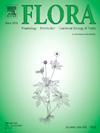Which habitat element has the critical impact on photosynthetic pigments, carbohydrates, and antioxidant defense in epiphytic mosses?
IF 1.8
4区 生物学
Q3 ECOLOGY
引用次数: 0
Abstract
Mosses, as an essential component of the Hyrcanian Forest ecosystem, are influenced by various ecological factors. The current study aimed to investigate the role of habitat elements on the concentration of photosynthetic pigments, carbohydrates, antioxidant compounds, and antioxidative enzymes activity in three native epiphytic moss species from the Neckeraceae family: Forsstroemia remotifolia, Homalia besseri, and Neckera complanata. The mosses were collected from the Hyrcanian Forest in Golestan Province, northern Iran, along three bands of an elevational transect with different climatic conditions. The results revealed that in H. besseri and F. remotifolia the metabolite concentrations and antioxidative enzyme activities were not correlated with elevation or associated climatic factors. Instead, they were strongly influenced by the characteristics of their host trees. Notably, the patterns of change in metabolites including chlorophyll a and b, soluble carbohydrates, proteins, phenols, and the activity of antioxidative enzymes such as superoxide dismutase (SOD) and peroxidase were similar in these two moss species, regardless of whether they were collected from low or high elevations. This similarity may be attributed to their common host tree, Parrotia persica. It appears that the host tree plays a significant role in shaping the mosses’ metabolite profiles particularly through traits such as bark thickness and pH. In contrast, the metabolite composition in N. complanata, including photosynthetic pigments, soluble proteins, flavonols, and SOD activity, was influenced by both the host tree and elevation. Moreover, N. complanata exhibited different responses to host tree features (bark thickness and pH) compared to H. besseri and F. remotifolia. This study concludes that host tree characteristics play a pivotal role in modulating the physiological responses of epiphytic mosses, revealing species-specific sensitivities to elevational gradients. The findings emphasize the intricate interaction between host bark traits and abiotic environmental factors in shaping moss metabolism within the Hyrcanian Forest ecosystem.
哪种生境元素对附生苔藓的光合色素、碳水化合物和抗氧化防御有关键影响?
苔藓作为海卡尼亚森林生态系统的重要组成部分,受到多种生态因子的影响。本研究旨在研究生境元素对3种内生藓科植物(Forsstroemia remotifolia, Homalia besseri和Neckera complanata)光合色素浓度、碳水化合物、抗氧化化合物和抗氧化酶活性的影响。这些苔藓是在伊朗北部Golestan省的hycanian森林中沿不同气候条件的海拔样带收集的。结果表明,贝塞氏螺旋体和远叶螺旋体的代谢物浓度和抗氧化酶活性与海拔及相关气候因子无关。相反,它们受到寄主树木特征的强烈影响。值得注意的是,无论是在低海拔还是高海拔地区采集的两种苔藓,其代谢产物(包括叶绿素a和b)、可溶性碳水化合物、蛋白质、酚类物质以及超氧化物歧化酶(SOD)和过氧化物酶等抗氧化酶的活性的变化模式都是相似的。这种相似性可能归因于它们共同的寄主树——桃香树。结果表明,寄主树对苔藓代谢物的形成起着重要的作用,特别是通过树皮厚度和ph等性状。相比之下,拟南芥的代谢物组成,包括光合色素、可溶性蛋白、黄酮醇和SOD活性,受到寄主树和海拔的影响。此外,与贝氏木和远叶木相比,平叶木对寄主树特征(树皮厚度和pH值)的响应有所不同。本研究认为,寄主树的特征在调节附生苔藓的生理反应中起着关键作用,揭示了物种对海拔梯度的敏感性。研究结果强调了寄主树皮特征和非生物环境因素之间复杂的相互作用在塑造海卡尼亚森林生态系统中苔藓代谢。
本文章由计算机程序翻译,如有差异,请以英文原文为准。
求助全文
约1分钟内获得全文
求助全文
来源期刊

Flora
生物-植物科学
CiteScore
3.30
自引率
10.50%
发文量
130
审稿时长
54 days
期刊介绍:
FLORA publishes original contributions and review articles on plant structure (morphology and anatomy), plant distribution (incl. phylogeography) and plant functional ecology (ecophysiology, population ecology and population genetics, organismic interactions, community ecology, ecosystem ecology). Manuscripts (both original and review articles) on a single topic can be compiled in Special Issues, for which suggestions are welcome.
FLORA, the scientific botanical journal with the longest uninterrupted publication sequence (since 1818), considers manuscripts in the above areas which appeal a broad scientific and international readership. Manuscripts focused on floristics and vegetation science will only be considered if they exceed the pure descriptive approach and have relevance for interpreting plant morphology, distribution or ecology. Manuscripts whose content is restricted to purely systematic and nomenclature matters, to geobotanical aspects of only local interest, to pure applications in agri-, horti- or silviculture and pharmacology, and experimental studies dealing exclusively with investigations at the cellular and subcellular level will not be accepted. Manuscripts dealing with comparative and evolutionary aspects of morphology, anatomy and development are welcome.
 求助内容:
求助内容: 应助结果提醒方式:
应助结果提醒方式:


